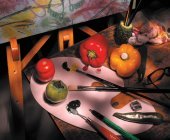|
Soft LightSoft light used in photography has its own properties. Any source of light is considered as a soft source of light, when it does not produce a distinguishable shadow. Shadow area is rendered as shading, which has no defined shape. In nature, this light is produced, when the sun light is obstructed by dense clouds. We cannot spot location of the sun and light is coming from all directions. In a studio, this light is produced by using a large soft box. It can also be produced by using a large acrylic sheet in front of a studio flash or by bouncing back the flash light from a reflector.
This type of light wraps the subject with almost same illumination from all directions. (except the opposite side of the subject.) The result is calm and soothing to eyes as unwanted details and texture is not showing their character. For delicate subjects like flowers or children, this light is a must as it enhances the smoothness and delicacy of the surface. We can further enhance the misty look in photograph by using a soft focus filter. However, in landscape and architectural genre of photography, this type of light produces a dull and boring atmosphere. Use of soft light in photography will depend on nature of the surface of the subject. Surface of the subject can be smooth and polished like a snooker ball, semi-matt like skin or matt like a tennis ball. As a polished surface reflects the source of light as high light, soft form of light will produce a convincing result, especially if the light source has a simple defined shape. This shape will be visible as a reflection in the subject and the distorted shape (because of shape and form of the subject) will help to show the nature of surface, shape and form in a simple way. On semi-matt surface, this type of light can be used, if we prefer to remove unwanted and too much texture details. So when the subject is a child or a female model, we can use this light but if the texture, as an element, is a part of composition, then this light cannot be the key light, but can be used for opening up the shadow details and to reduce contrast. For matt and rough surface, this light is generally not required. However, the choice is subjective. Softening of the light should not be confused with intensity or brightness of the light, though when we soften a light source, its brightness is reduced. In a studio, this loss is compensated by using much powerful flash light in the soft box. In nature, this loss is covered by the use of either a slower shutter speed, wider aperture or increased ISO value.
Read about Medium light and its use in photography
|






